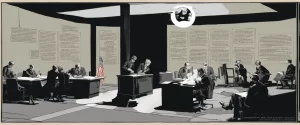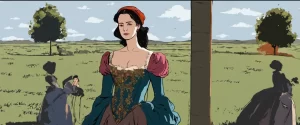
In the ever-evolving landscape of business and innovation, intellectuals have always sought to decipher the mystifying factors that lead some organizations to prosper while others falter. Keeping pace with the rapidly changing times and making informed decisions becomes an increasingly vital skill for entrepreneurs and leaders alike. Two captivating books, “Seeing What’s Next” by Clayton M. Christensen and “Think Again” by Adam M. Grant, offer profound insights into the realm of strategic thinking and decision-making processes.
Clayton M. Christensen, renowned business expert and Harvard professor, is widely recognized for his groundbreaking work on disruptive innovation. In “Seeing What’s Next,” Christensen, together with co-authors Erik A. Roth and Scott D. Anthony, delves deep into the world of prediction and foresight. By examining patterns and trends across various industries, the authors uncover the hidden mechanics that shape future market dynamics. Armed with compelling case studies and extensive research, the book equips leaders with the ability to anticipate disruptions and seize untapped opportunities.
On the other hand, Adam M. Grant, organizational psychologist and professor at the Wharton School, approaches the topic of decision-making from a different perspective. In his thought-provoking book, “Think Again,” Grant challenges the fixed mindset that often hinders personal and professional growth. Through captivating narratives and scientific research, Grant offers readers a fresh outlook on the power of rethinking assumptions, reframing challenges, and embracing intellectual humility. He argues that knowing when to question our beliefs and explore different viewpoints ultimately leads to better decision-making and unlocks greater potential for innovation.
While both “Seeing What’s Next” and “Think Again” tackle the intricacies of strategic thinking and decision-making, they do so from distinct angles. Christensen’s work centers around industry patterns and disruptive innovation, providing readers with a systematic approach to anticipate future changes. On the other hand, Grant’s emphasis lies on personal introspection and challenging traditional wisdom, urging individuals to reconsider their preconceived notions and embrace intellectual flexibility.
This comparative study aims to examine the similarities and differences between these two influential works, shedding light on the diverse methodologies and philosophies they employ to navigate the complex world of decision-making. By exploring the strengths and limitations of both books, we seek to extract practical insights that can be applied in practice, whether in the realm of business or personal growth. Join us on this intellectual exploration and embark on a journey of discovery that will deepen our understanding of strategic thinking and facilitate more effective decision-making.
Brief Summary of Two Books
Seeing What’s Next by Clayton M. Christensen
Seeing What’s Next” by Clayton M. Christensen is a thought-provoking guide that explores the theory of disruptive innovation and how leaders can successfully anticipate and navigate it. Drawing upon a wide range of industries and case studies, the book offers insights into how disruptive technologies and business models can upend established companies and markets.
The authors introduce the concept of “disruptive innovation,” which refers to the transformation of an industry or market brought about by an unexpected entrant. They argue that by understanding the patterns and indicators of disruption, leaders can better prepare their organizations for the future.
Throughout the book, Christensen and his co-authors examine various industries, such as healthcare, education, and media, providing examples of disruptive innovations that have reshaped these sectors. They offer frameworks to analyze disruptions, such as the six principles of disruptive growth and the theory of jobs to be done, which help identify opportunities for innovation.
The book also emphasizes the importance of experimentation and adaptability in navigating disruptive change. It highlights the need for leaders to be open-minded, willing to challenge existing assumptions, and embrace new business models that emerge as a result of disruptive innovations.
In conclusion, “Seeing What’s Next” offers readers valuable insights into the dynamics of disruptive innovation and provides strategic frameworks for leaders to anticipate and respond effectively to industry disruptions. It acts as a guide for those seeking to gain an advantage in an increasingly fast-paced and disruptive business environment.
Think Again by Adam M. Grant
Think Again” by Adam M. Grant is a thought-provoking book that challenges the reader’s beliefs and encourages them to reassess their perspectives. Grant argues that the ability to change one’s mind is not a weakness but a strength. He explains the concept of “mental flexibility” and provides numerous real-life examples and scientific evidence to support his ideas.
The book is divided into three parts, starting with a discussion on the importance of challenging our own assumptions. Grant explores the psychological barriers that prevent us from thinking again, such as cognitive biases, tribalism, and our fear of being wrong. He emphasizes the need for intellectual humility and curiosity in order to effectively reevaluate our thoughts and opinions.
In the second part, Grant explores the benefits of rethinking in various aspects of life, including personal relationships, work, and politics. He presents compelling stories of individuals and organizations that have successfully embraced the practice of thinking again and benefited from it. The author highlights the transformational power of open-mindedness and encourages readers to seek out diverse opinions and engage in constructive conversations.
The final section of the book focuses on practical strategies to cultivate the habit of thinking again. Grant provides helpful tips on how to challenge our own beliefs, navigate disagreements with others, and create a culture that embraces rethinking in organizations. He also addresses the common challenges and fears associated with changing one’s mind.
Overall, “Think Again” is a persuasive and compelling book that urges readers to question their assumptions, embrace the process of reevaluating their views, and ultimately enhance their decision-making abilities. Grant’s insights and research-backed arguments make a convincing case for the importance of intellectual flexibility in our personal and professional lives.
Comparison between Two Books

Similarities in Decision-making
Both “Seeing What’s Next” by Clayton M. Christensen and “Think Again” by Adam M. Grant, although exploring different topics, share some similarities when it comes to decision-making:
1. Importance of gathering diverse perspectives: Both books emphasize the value of considering multiple viewpoints before making decisions. Christensen asserts that successful forecasting requires the involvement of different disciplines, industries, and perspectives. Similarly, Grant suggests the need to seek out information and opinions that challenge our own ideas and beliefs to ensure better decision-making.
2. Evaluating assumptions and underlying data: Both authors stress the significance of critically assessing the assumptions and data that drive decision-making. Christensen argues that accurate predictions require going beyond surface-level observations and understanding the underlying causes and dynamics. Grant challenges readers to reevaluate their assumptions and beliefs continually in light of new evidence, avoiding cognitive biases that may cloud judgment.
3. Flexibility in decision-making processes: Both books emphasize the necessity of adaptability in decision-making. Christensen discusses the importance of learning from failures and being willing to adjust strategies accordingly. Grant encourages readers to embrace intellectual humility by recognizing when they need to rethink their decisions and take feedback from others.
4. Considering long-term consequences: Both authors highlight the need to consider the long-term effects of decisions. Christensen emphasizes the importance of strategic thinking about technology trends and their impact on industries and markets. Grant argues against short-sighted decision-making and advocates for considering the broader consequences of our choices on ourselves and others.
5. Avoiding overconfidence and complacency: Both books caution against overconfidence and the dangers of becoming too comfortable with our beliefs and decisions. Christensen warns against the arrogance that can come from past successes, leading to missed opportunities or wrong predictions. Grant encourages readers to be open to new information and be willing to change their minds, avoiding the trap of intellectual complacency.
In summary, both “Seeing What’s Next” and “Think Again” emphasize the need for diverse perspectives, critical evaluation of assumptions and data, flexibility, consideration of long-term consequences, and avoiding overconfidence. By understanding and applying these principles, decision-makers can enhance their ability to make informed and effective choices.
Divergences in Decision-making
Seeing What’s Next by Clayton M. Christensen and Think Again by Adam M. Grant are both highly insightful books that discuss different aspects of decision-making, although they approach the topic from distinct angles. Below are a few key divergences in their perspectives on decision-making:
1. Approach to decision-making:
– In Seeing What’s Next, Christensen primarily focuses on disruptive technologies and how companies can make strategic choices to adapt and succeed in their industry. His emphasis is on decision-making within the realm of business and innovation. Christensen urges decision-makers to identify disruptive technologies early and make choices that align with market dynamics.
– On the other hand, Think Again by Grant takes a broader view of decision-making, applicable to various aspects of life. Grant explores cognitive flexibility, the ability to reevaluate one’s beliefs, and the importance of intellectual humility. His central thesis is that decision-makers should be open-minded and willing to challenge their assumptions, which can lead to better outcomes in personal and professional domains.
2. Influence on decision-making factors:
– Christensen’s book centers around the concept of “disruptive innovation” and how it shapes decision-making. He highlights the significance of anticipating future market conditions, technological advancements, and emerging competitive landscapes. Christensen suggests that decision-makers should identify and respond to disruptive forces proactively to stay ahead.
– In contrast, Grant focuses on the psychological and social factors that impact decision-making in Think Again. He emphasizes the importance of empathy, curiosity, and embracing diverse perspectives to overcome biases and make more effective decisions. Grant argues that decision-makers should actively seek out and incorporate different viewpoints, challenging their own assumptions for more comprehensive decision-making.
3. Empirical evidence and analytical frameworks:
– Seeing What’s Next draws heavily on historical case studies and empirical evidence to support its arguments. Christensen offers frameworks such as the “theory of disruptive innovation” and “jobs-to-be-done theory” to guide decision-making in the face of disruption. He presents a structured approach to decision-making backed by research and insights from various industries.
– Think Again, in contrast, relies more on behavioral science research, experiments, and anecdotes to illustrate its ideas. Grant uses these examples to demonstrate the benefits of reevaluating one’s assumptions and the drawbacks of intellectual rigidity in both personal and professional decision-making. While Grant also references studies and research, his approach is more narrative-driven.
In summary, while both books are rich in wisdom about decision-making, they focus on distinct aspects. Seeing What’s Next delves into strategic decision-making within the context of business and disruptive innovation. Think Again shifts the focus to a broader view of decision-making, emphasizing cognitive flexibility, intellectual humility, and exploring personal biases.

Conclusion
Both “Seeing What’s Next” by Clayton M. Christensen and “Think Again” by Adam M. Grant are highly regarded and offer valuable insights. The choice between the two depends on your specific interests and needs.
“Seeing What’s Next” focuses on understanding disruptive innovations and how to predict their impact on industries and businesses. It provides frameworks and strategies for identifying emerging trends and successfully navigating technological and market changes. If you are interested in innovation, strategy, and the future of industries, this book may be more relevant to you.
On the other hand, “Think Again” explores the importance of intellectual humility, open-mindedness, and being willing to change one’s opinions. It examines the psychology behind stubbornness, embracing doubt, unlearning, and rethinking assumptions. If you are interested in personal growth, self-reflection, and challenging your own beliefs, this book may be more beneficial to you.
Ultimately, it depends on your individual preferences and which topic resonates with you more. Both books are highly recommended, so consider the one that aligns better with your current interests or goals.



